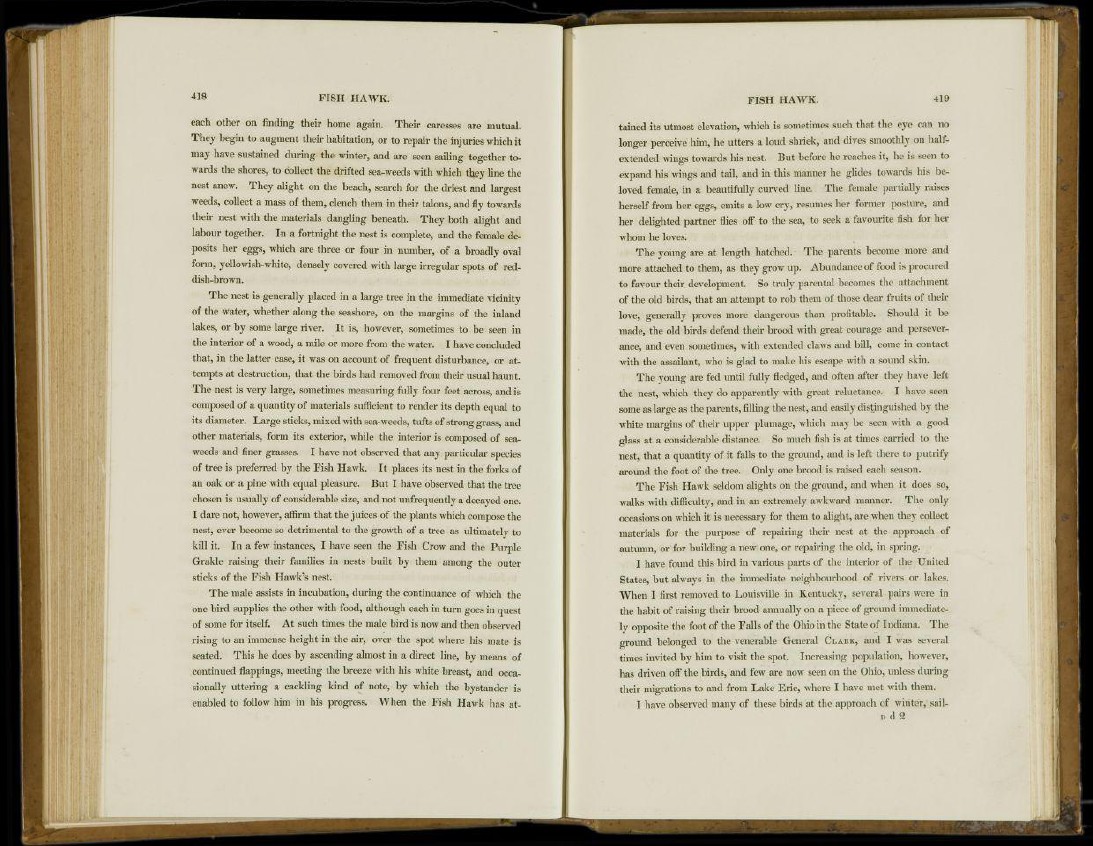
each other on finding their home again. Their caresses are mutual.
They begin to augment their habitation, or to repair the injuries which it
may have sustained during the winter, and are seen sailing together towards
the shores, to collect the drifted sea-weeds with which they line the
nest anew. They alight on the beach, search for the driest and largest
weeds, collect a mass of them, clench them in their talons, and fly towards
their nest with the materials dangling beneath. They both alight and
labour together. In a fortnight the nest is complete, and the female deposits
her eggs, which are three or four in number, of a broadly oval
form, yellowish-white, densely covered with large irregular spots of reddish
brown.
The nest is generally placed in a large tree in the immediate vicinity
of the water, whether along the seashore, on the margins of the inland
lakes, or by some large river. It is, however, sometimes to be seen in
the interior of a wood, a mile or more from the water. I have concluded
that, in the latter case, it was on account of frequent disturbance, or attempts
at destruction, that the birds had removed from their usual haunt.
The nest is very large, sometimes measuring fully four feet across, and is
composed of a quantity of materials sufficient to render its depth equal to
its diameter. Large sticks, mixed with sea-weeds, tufts of strong grass, and
other materials, form its exterior, while the interior is composed of seaweeds
and finer grasses. I have not observed that any particular species
of tree is preferred by the Fish Hawk. It places its nest in the forks of
an oak or a pine with equal pleasure. But I have observed that the tree
chosen is usually of considerable size, and not unfrequently a decayed one.
I dare not, however, affirm that the juices of the plants which compose the
nest, ever become so detrimental to the growth of a tree as ultimately to
kill it. In a few instances, I have seen the Fish Crow and the Purple
Grakle raising their families in nests built by them among the outer
sticks of the Fish Hawk's nest.
The male assists in incubation, during the continuance of which the
one bird supplies the other with food, although each in turn goes in quest
of some for itself. At such times the male bird is now and then observed
rising to an immense height in the air, over the spot where his mate is
seated. This he does by ascending almost in a direct line, by means of
continued flappings, meeting the breeze with his white breast, and occasionally
uttering a cackling kind of note, by which the bystander is
enabled to follow him in his progress. When the Fish Hawk has attained
its utmost elevation, which is sometimes such that the eye can no
longer perceive him, he utters a loud shriek, and dives smoothly on halfextended
wings towards his nest. But before he reaches it, he is seen to
expand his wings and tail, and in this manner he glides towards his beloved
female, in a beautifully curved line. The female partially raises
herself from her eggs, emits a low cry, resumes her former posture, and
her delighted partner flies off to the sea, to seek a favourite fish for her
whom he loves.
The young are at length hatched. The parents become more and
more attached to them, as they grow up. Abundance of food is procured
to favour their development. So truly parental becomes the attachment
of the old birds, that an attempt to rob them of those dear fruits of their
love, generally proves more dangerous than profitable. Should it be
made, the old birds defend their brood with great courage and perseverance,
and even sometimes, with extended claws and bill, come in contact
with the assailant, who is glad to make his escape with a sound skin.
The young are fed until fully fledged, and often after they have left
the nest, which they do apparently with great reluctance. I have seen
some as large as the parents, filling the nest, and easily distinguished by the
white margins of their upper plumage, which may be seen with a good
glass at a considerable distance. So much fish is at times carried to the
nest, that a quantity of it falls to the ground, and is left there to putrify
around the foot of the tree. Only one brood is raised each season.
The Fish Hawk seldom alights on the ground, and when it does so,
walks with difficulty, and in an extremely awkward manner. The only
occasions on which it is necessary for them to alight, are when they collect
materials for the purpose of repairing their nest at the approach of
autumn, or for building a new one, or repairing the old, in spring.
I have found this bird in various parts of the interior of the United
States, but always in the immediate neighbourhood of rivers or lakes.
When I first removed to Louisville in Kentucky, several pairs were in
the habit of raising their brood annually on a piece of ground immediately
opposite the foot of the Falls of the Ohio in the State of Indiana. The
ground belonged to the venerable General CLARK, and I was several
times invited by him to visit the spot. Increasing population, however,
has driven off the birds, and few are now seen on the Ohio, unless during
their migrations to and from Lake Erie, where I have met with them.
I have observed many of these birds at the approach of winter, s.iili)
d 2